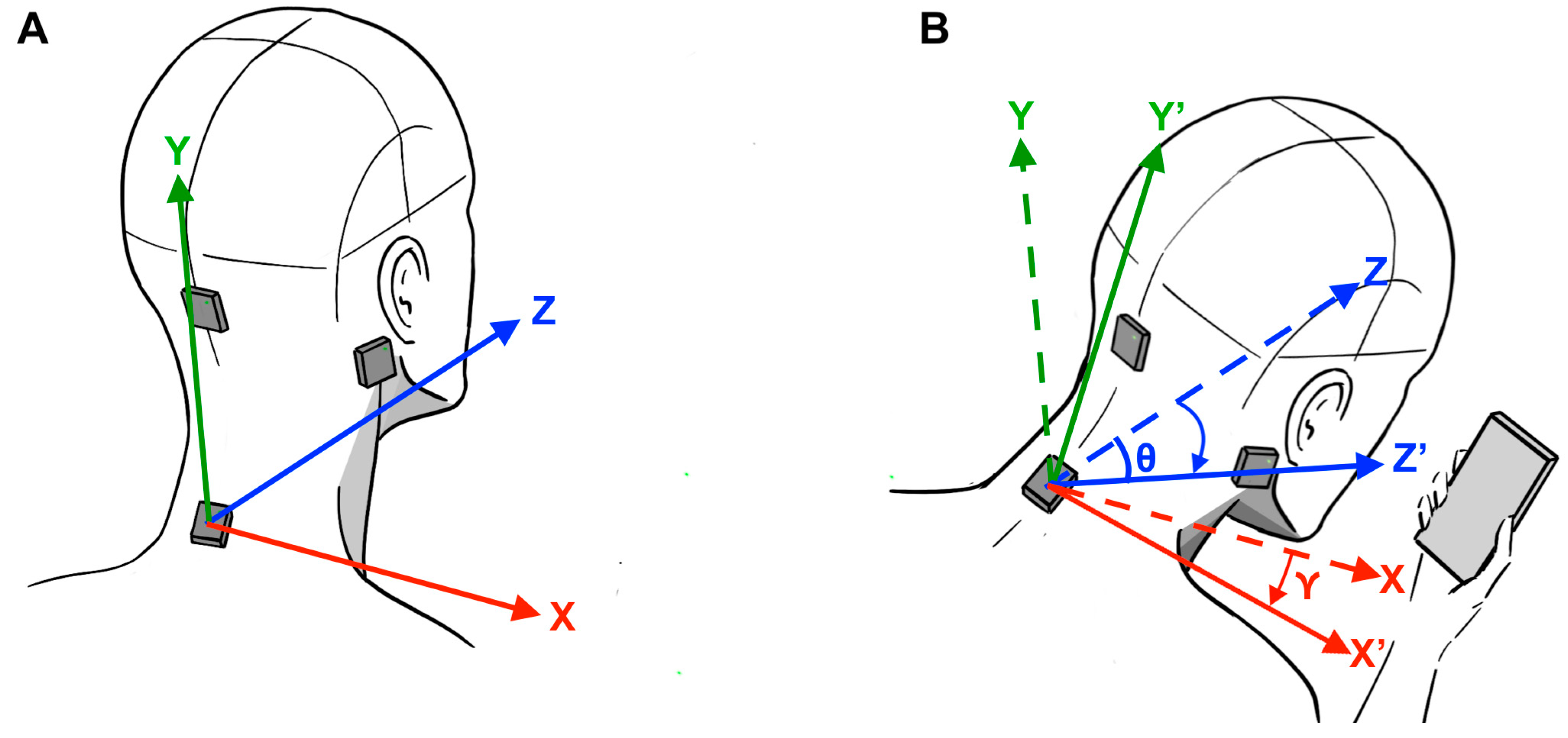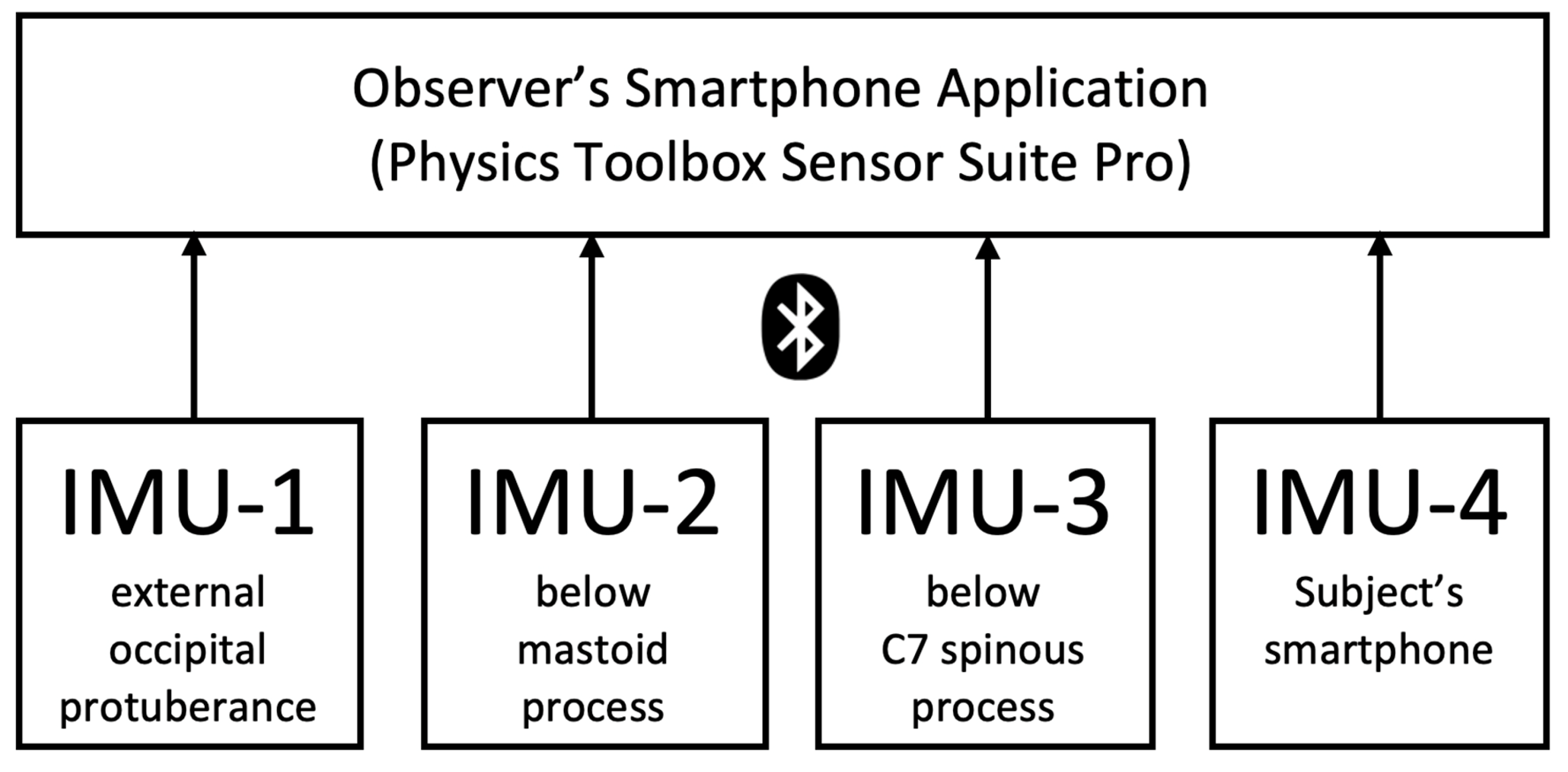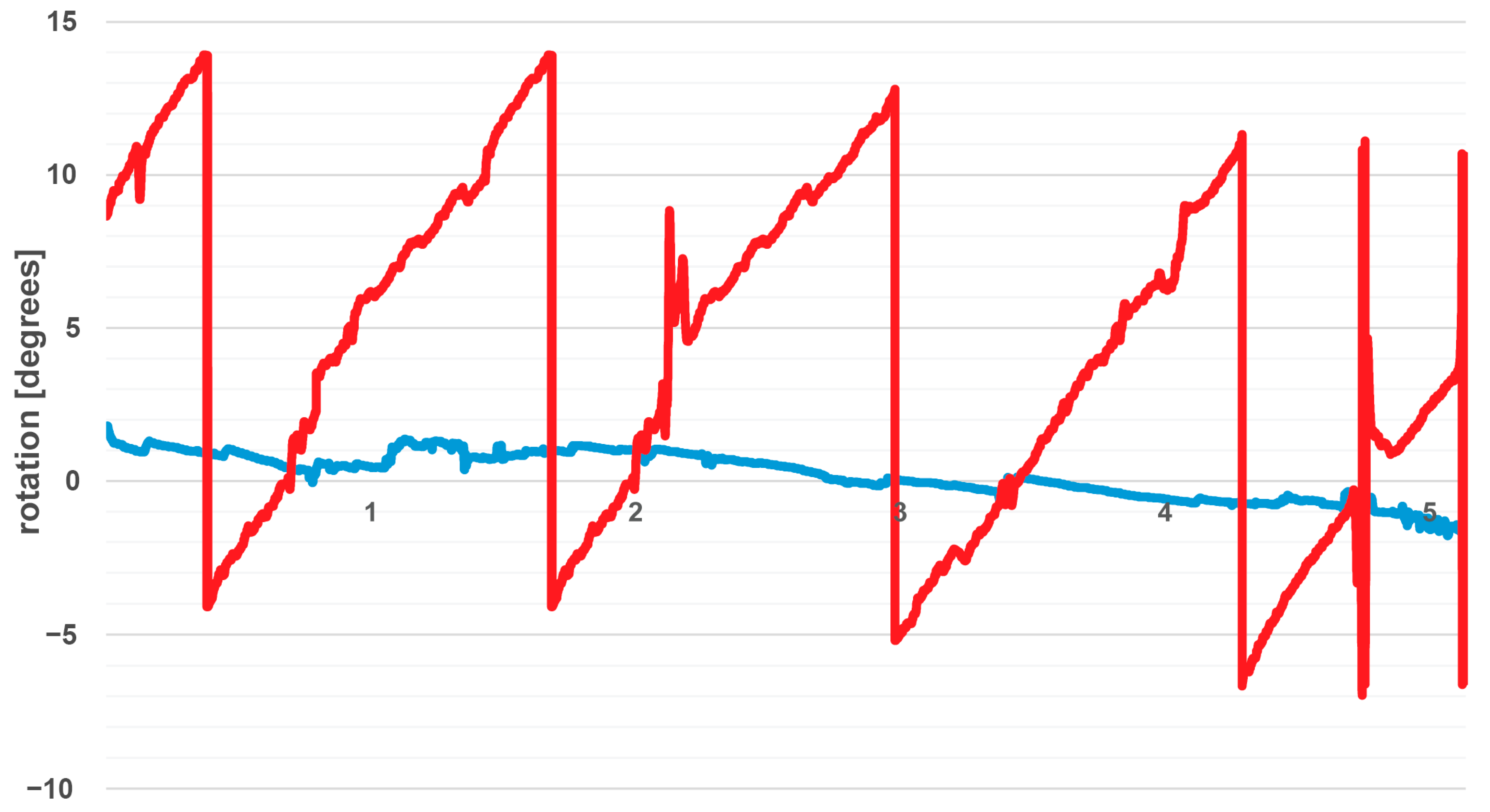Kinematic Analysis of the Forward Head Posture Associated with Smartphone Use
Abstract
1. Introduction
2. Materials and Methods
2.1. Inclusion Criteria
2.2. Apparatus and Sensor Attachment Points
2.3. Tasks and Measurements
2.4. Segment Angle Calculation
2.5. Symmetry Analysis
3. Results
4. Discussion
5. Study Limitations
6. Conclusions
Author Contributions
Funding
Data Availability Statement
Conflicts of Interest
References
- Bevan, S. Economic Impact of Musculoskeletal Disorders (MSDs) on Work in Europe. Best Pract. Res. Clin. Rheumatol. 2015, 29, 356–373. [Google Scholar] [CrossRef] [PubMed]
- da Costa, B.R.; Vieira, E.R. Risk Factors for Work-Related Musculoskeletal Disorders: A Systematic Review of Recent Longitudinal Studies. Am. J. Ind. Med. 2010, 53, 285–323. [Google Scholar] [CrossRef] [PubMed]
- Derakhshanrad, N.; Yekaninejad, M.S.; Mehrdad, R.; Saberi, H. Neck Pain Associated with Smartphone Overuse: Cross-Sectional Report of a Cohort Study among Office Workers. Eur. Spine J. 2021, 30, 461–467. [Google Scholar] [CrossRef]
- Al-Hadidi, F.; Bsisu, I.; AlRyalat, S.A.; Al-Zu’bi, B.; Bsisu, R.; Hamdan, M.; Kanaan, T.; Yasin, M.; Samarah, O. Association between Mobile Phone Use and Neck Pain in University Students: A Cross-Sectional Study Using Numeric Rating Scale for Evaluation of Neck Pain. PLoS ONE 2019, 14, e0217231. [Google Scholar] [CrossRef]
- Alsalameh, A.M.; Harisi, M.J.; Alduayji, M.A.; Almutham, A.A.; Mahmood, F.M. Evaluating the Relationship between Smartphone Addiction/Overuse and Musculoskeletal Pain among Medical Students at Qassim University. J. Fam. Med. Prim. Care 2019, 8, 2953. [Google Scholar] [CrossRef]
- Mustafaoglu, R.; Yasaci, Z.; Zirek, E.; Griffiths, M.D.; Ozdincler, A.R. The Relationship between Smartphone Addiction and Musculoskeletal Pain Prevalence among Young Population: A Cross-Sectional Study. Korean J. Pain 2021, 34, 72. [Google Scholar] [CrossRef]
- Fares, J.; Fares, M.Y.; Fares, Y. Musculoskeletal Neck Pain in Children and Adolescents: Risk Factors and Complications. Surg. Neurol. Int. 2017, 8, 72. [Google Scholar] [CrossRef]
- Hansraj, K.K. Assessment of Stresses in the Cervical Spine Caused by Posture and Position of the Head. Surg. Technol. Int. 2014, 25, 277–279. [Google Scholar]
- Jones, G.T.; Silman, A.J.; Power, C.; Macfarlane, G.J. Are Common Symptoms in Childhood Associated with Chronic Widespread Body Pain in Adulthood? Results from the 1958 British Birth Cohort Study. Arthritis Rheum. 2007, 56, 1669–1675. [Google Scholar] [CrossRef]
- Brattberg, G. Do Pain Problems in Young School Children Persist into Early Adulthood? A 13-Year Follow-Up. Eur. J. Pain 2004, 8, 187–199. [Google Scholar] [CrossRef]
- Hestbaek, L.; Leboeuf-Yde, C.; Kyvik, K.O.; Manniche, C. The Course of Low Back Pain from Adolescence to Adulthood: Eight-Year Follow-up of 9600 Twins. Spine 2006, 31, 468–472. [Google Scholar] [CrossRef] [PubMed]
- GBD Compare|IHME Viz Hub. Available online: https://vizhub.healthdata.org/gbd-compare/ (accessed on 21 July 2021).
- David, D.; Giannini, C.; Chiarelli, F.; Mohn, A. Text Neck Syndrome in Children and Adolescents. Int. J. Environ. Res. Public Health 2021, 18, 1565. [Google Scholar] [CrossRef]
- Zhuang, L.; Wang, L.; Xu, D.; Wang, Z.; Liang, R. Association between Excessive Smartphone Use and Cervical Disc Degeneration in Young Patients Suffering from Chronic Neck Pain. J. Orthop. Sci. 2021, 26, 110–115. [Google Scholar] [CrossRef] [PubMed]
- Çevik, S.; Kaplan, A.; Katar, S. Correlation of Cervical Spinal Degeneration with Rise in Smartphone Usage Time in Young Adults. Niger. J. Clin. Pract. 2020, 23, 1748–1752. [Google Scholar] [CrossRef] [PubMed]
- Xie, Y.F.; Szeto, G.; Madeleine, P.; Tsang, S. Spinal Kinematics during Smartphone Texting—A Comparison between Young Adults with and without Chronic Neck-Shoulder Pain. Appl. Ergon. 2018, 68, 160–168. [Google Scholar] [CrossRef] [PubMed]
- Beange, K.H.E.; Chan, A.D.C.; Beaudette, S.M.; Graham, R.B. Concurrent Validity of a Wearable IMU for Objective Assessments of Functional Movement Quality and Control of the Lumbar Spine. J. Biomech. 2019, 97, 109356. [Google Scholar] [CrossRef] [PubMed]
- Vignais, N.; Miezal, M.; Bleser, G.; Mura, K.; Gorecky, D.; Marin, F. Innovative System for Real-Time Ergonomic Feedback in Industrial Manufacturing. Appl. Ergon. 2013, 44, 566–574. [Google Scholar] [CrossRef]
- Yan, X.; Li, H.; Li, A.R.; Zhang, H. Wearable IMU-Based Real-Time Motion Warning System for Construction Workers’ Musculoskeletal Disorders Prevention. Autom. Constr. 2017, 74, 2–11. [Google Scholar] [CrossRef]
- Huang, C.; Kim, W.; Zhang, Y.; Xiong, S. Development and Validation of a Wearable Inertial Sensors-Based Automated System for Assessing Work-Related Musculoskeletal Disorders in the Workspace. Int. J. Environ. Res. Public Health 2020, 17, 6050. [Google Scholar] [CrossRef]
- Neupane, S.; Ali, U.; Mathew, A. Text Neck Syndrome—Systematic Review. Imp. J. Interdiscip. Res. 2017, 3, 141–148. [Google Scholar]
- Barrett, J.M.; McKinnon, C.; Callaghan, J.P. Cervical Spine Joint Loading with Neck Flexion. Ergonomics 2019, 63, 101–108. [Google Scholar] [CrossRef] [PubMed]
- AlAbdulwahab, S.S.; Kachanathu, S.J.; AlMotairi, M.S. Smartphone Use Addiction Can Cause Neck Disability. Musculoskelet. Care 2017, 15, 10–12. [Google Scholar] [CrossRef]
- Chu, E.C.-P.; Wong, A.Y.-L. Cervicogenic Dizziness in an 11-Year-Old Girl: A Case Report. Adolesc. Health Med. Ther. 2021, 12, 111–116. [Google Scholar] [CrossRef] [PubMed]
- Kim, H.K.; Kim, N.; Park, J. Relationship Analysis between Body Flexion Angles and Smartphone Tilt during Smartphone Use. Int. J. Ind. Ergon. 2020, 80, 103034. [Google Scholar] [CrossRef]
- Dubousset, J. Three-Dimensional Analysis of the Scoliotic Deformity. In The Pediatric Spine: Principles and Practice; Elsevier: Amsterdam, The Netherlands, 1994. [Google Scholar]
- Haddas, R.; Lieberman, I.; Boah, A.; Arakal, R.; Belanger, T.; Ju, K.L. Functional Balance Testing in Cervical Spondylotic Myelopathy Patients. Spine 2019, 44, 103–109. [Google Scholar] [CrossRef] [PubMed]
- Haddas, R.; Lieberman, I.H. A Method to Quantify the “Cone of Economy”. Eur. Spine J. 2018, 27, 1178–1187. [Google Scholar] [CrossRef] [PubMed]
- Iyer, S.; Sheha, E.; Fu, M.C.; Varghese, J.; Cunningham, M.E.; Albert, T.J.; Schwab, F.J.; Lafage, V.C.; Kim, H.J. Sagittal Spinal Alignment in Adult Spinal Deformity: An Overview of Current Concepts and a Critical Analysis Review. JBJS Rev. 2018, 6, e2. [Google Scholar] [CrossRef]
- Parr, M.J.C.; Miller, M.E.; Bridges, N.R.; Buhrman, J.R.; Perry, C.E.; Wright, N.L. Evaluation of the Nij Neck Injury Criteria with Human Response Data for Use in Future Research on Helmet Mounted Display Mass Properties. Proc. Hum. Factors Ergon. Soc. Annu. Meet. 2012, 56, 2070–2074. [Google Scholar] [CrossRef]
- Prasad, P.; Mertz, H.J.; Dalmotas, D.J.; Augenstein, J.S.; Digges, K. Evaluation of the Field Relevance of Several Injury Risk Functions. Stapp Car Crash J. 2010, 54, 49. [Google Scholar] [CrossRef]
- Vital, J.M.; Senegas, J. Anatomical Bases of the Study of the Constraints to Which the Cervical Spine Is Subject in the Sagittal Plane A Study of the Center of Gravity of the Head. Surg. Radiol. Anat. 1986, 8, 169–173. [Google Scholar] [CrossRef]
- Xie, Y.; Szeto, G.P.Y.; Dai, J.; Madeleine, P. A Comparison of Muscle Activity in Using Touchscreen Smartphone among Young People with and without Chronic Neck–Shoulder Pain. Ergonomics 2015, 59, 61–72. [Google Scholar] [CrossRef] [PubMed]
- Carbonaro, N.; Mascherini, G.; Bartolini, I.; Ringressi, M.N.; Taddei, A.; Tognetti, A.; Vanello, N. A Wearable Sensor-Based Platform for Surgeon Posture Monitoring: A Tool to Prevent Musculoskeletal Disorders. Int. J. Environ. Res. Public Health 2021, 18, 3734. [Google Scholar] [CrossRef] [PubMed]
- Franco, L.; Sengupta, R.; Wade, L.; Cazzola, D. A Novel IMU-Based Clinical Assessment Protocol for Axial Spondyloarthritis: A Protocol Validation Study. PeerJ 2021, 9, e10623. [Google Scholar] [CrossRef] [PubMed]
- Zhang, Y.; Haghighi, P.D.; Burstein, F.; Yap, L.W.; Cheng, W.; Yao, L.; Cicuttini, F. Electronic Skin Wearable Sensors for Detecting Lumbar–Pelvic Movements. Sensors 2020, 20, 1510. [Google Scholar] [CrossRef]
- Shin, S.S.; Yoo, W. gyu Inertial Measurement Unit-Based Evaluation of Global and Regional Lumbar Spine and Pelvis Alignment in Standing Individuals with a Flat Lumbar Posture. J. Manip. Physiol. Ther. 2019, 42, 594–600. [Google Scholar] [CrossRef]
- Aranda-Valera, I.C.; Cuesta-Vargas, A.; Garrido-Castro, J.L.; Gardiner, P.V.; López-Medina, C.; Machado, P.M.; Condell, J.; Connolly, J.; Williams, J.M.; Muñoz-Esquivel, K.; et al. Measuring Spinal Mobility Using an Inertial Measurement Unit System: A Validation Study in Axial Spondyloarthritis. Diagnostics 2020, 10, 426. [Google Scholar] [CrossRef]




Disclaimer/Publisher’s Note: The statements, opinions and data contained in all publications are solely those of the individual author(s) and contributor(s) and not of MDPI and/or the editor(s). MDPI and/or the editor(s) disclaim responsibility for any injury to people or property resulting from any ideas, methods, instructions or products referred to in the content. |
© 2023 by the authors. Licensee MDPI, Basel, Switzerland. This article is an open access article distributed under the terms and conditions of the Creative Commons Attribution (CC BY) license (https://creativecommons.org/licenses/by/4.0/).
Share and Cite
Fercho, J.; Krakowiak, M.; Yuser, R.; Szmuda, T.; Zieliński, P.; Szarek, D.; Miękisiak, G. Kinematic Analysis of the Forward Head Posture Associated with Smartphone Use. Symmetry 2023, 15, 667. https://doi.org/10.3390/sym15030667
Fercho J, Krakowiak M, Yuser R, Szmuda T, Zieliński P, Szarek D, Miękisiak G. Kinematic Analysis of the Forward Head Posture Associated with Smartphone Use. Symmetry. 2023; 15(3):667. https://doi.org/10.3390/sym15030667
Chicago/Turabian StyleFercho, Justyna, Michał Krakowiak, Rami Yuser, Tomasz Szmuda, Piotr Zieliński, Dariusz Szarek, and Grzegorz Miękisiak. 2023. "Kinematic Analysis of the Forward Head Posture Associated with Smartphone Use" Symmetry 15, no. 3: 667. https://doi.org/10.3390/sym15030667
APA StyleFercho, J., Krakowiak, M., Yuser, R., Szmuda, T., Zieliński, P., Szarek, D., & Miękisiak, G. (2023). Kinematic Analysis of the Forward Head Posture Associated with Smartphone Use. Symmetry, 15(3), 667. https://doi.org/10.3390/sym15030667












